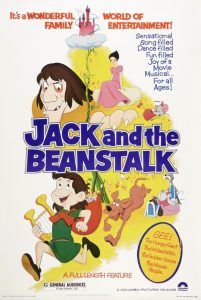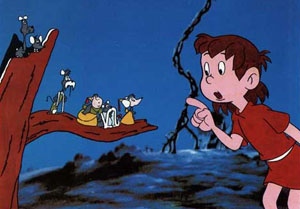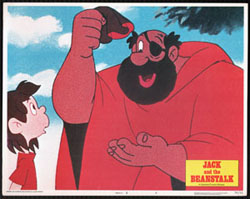 If you watched HBO in the ’80s, you probably remember the 1974 animated feature Jack and the Beanstalk. It was shown quite a bit on the cable platform during the decade, which is how a generation remembers it, or recalls it as a long-lost fever dream, when someone brings the movie up in conversation.
If you watched HBO in the ’80s, you probably remember the 1974 animated feature Jack and the Beanstalk. It was shown quite a bit on the cable platform during the decade, which is how a generation remembers it, or recalls it as a long-lost fever dream, when someone brings the movie up in conversation.
Jack and the Beanstalk also had an interesting path to movie screens. It was the first film produced by the then-new Japanese studio Group TAC, founded by staff from the studio Mushi Pro, which had gone bankrupt. That studio was not only responsible for the popular TV series Astro Boy and Kimba the White Lion but also provided animation to several Rankin/Bass holiday specials, such as Frosty the Snowman.
Mushi Pro had also made more adult-oriented animated features, such as 1970’s Cleopatra, which received an X rating. With Jack and the Beanstalk, the new Group TAC studio aimed to create a more traditional, musical animated fairy tale for a family audience.
Even with that, their take on Jack and the Beanstalk was still a decidedly different and, at times, darker version of the familiar fable.
 The film begins traditionally enough with Jack and his Mother deciding to sell the family’s cow. Jack meets an enigmatic, cloaked stranger with an eyepatch who convinces Jack to make the trade for “mysterious, miraculous and magical” beans.
The film begins traditionally enough with Jack and his Mother deciding to sell the family’s cow. Jack meets an enigmatic, cloaked stranger with an eyepatch who convinces Jack to make the trade for “mysterious, miraculous and magical” beans.
After he does and returns home, of course, his mother is upset and, tossing the beans outside, they sprout up into the mammoth beanstalk. Jack scales it into the clouds, accompanied by his sidekicks: his dog, Crosby, and a mouse named Laura.
When they arrive at the castle in the clouds, Jack and the Beanstalk begins to take its gloomier turn as they meet a mysterious young girl, Princess Margaret.
They also encounter the creepy Madame Hecuba, who seems welcoming but is actually an evil witch who has placed the princess under a spell and plans on having Margaret marry her son, “Tulip,” so that Hecuba can rule the kingdom. Jack is invited to dinner by Hecuba but is also placed under a sleeping spell by the witch.
 There’s somber music accompanied by slowly paced animation in these scenes that adds a horror movie quality to the proceedings, which only escalates as “Tulip,” a/k/a the Giant, enters the film. The character emerges looking less like a fairy-tale character and more like one of the Universal Monsters.
There’s somber music accompanied by slowly paced animation in these scenes that adds a horror movie quality to the proceedings, which only escalates as “Tulip,” a/k/a the Giant, enters the film. The character emerges looking less like a fairy-tale character and more like one of the Universal Monsters.
As Jack wakes, he attempts to escape from the castle and the Giant. He discovers a treasure trove with a talking harp and looks to help the Princess break her trance and break up the marriage to Tulip. The wedding sequence is another disturbing scene in Jack and the Beanstalk, playing out against funeral dirge-like music, with all the wedding guests portrayed as surrealistic paper-thin people conjured by Hecuba.
This year, Jack and the Beanstalk celebrates the 50th anniversary of its release in Japan on July 20th, 1974. The film was released on February 13th, 1976, in the United States. At the helm was director Gisaburō Sugii, a talented, prolific director who would also direct the acclaimed 1985 film Night on the Galactic Railroad.
 When released in the United States, many of the cast voices, such as Jack, his mother, Madame Hecuba and the harp, were provided by actress Billie Lou Watt, who also voiced the title character in Mushi Pro’s Astro Boy series.
When released in the United States, many of the cast voices, such as Jack, his mother, Madame Hecuba and the harp, were provided by actress Billie Lou Watt, who also voiced the title character in Mushi Pro’s Astro Boy series.
When it was initially released in the States by Columbia Pictures in 1976, Jack and the Beanstalk was dismissed by critics. Richard Eder wrote in the New York Times, “It is the kind of thing grandfathers are sent out to take their grandchildren to. They will sit silently, side by side, and a quiet loathing will spring up between them.”
However, it’s those grandchildren, their siblings, and friends who re-watched Jack and the Beanstalk during its multiple cable airings on HBO, and today flashback to that unique, offbeat, gloomier corner of animation history not with loathing but with rose-colored memories.


 Michael Lyons is a freelance writer, specializing in film, television, and pop culture. He is the author of the book, Drawn to Greatness: Disney’s Animation Renaissance, which chronicles the amazing growth at the Disney animation studio in the 1990s. In addition to Animation Scoop and Cartoon Research, he has contributed to Remind Magazine, Cinefantastique, Animation World Network and Disney Magazine. He also writes a blog, Screen Saver: A Retro Review of TV Shows and Movies of Yesteryear and his interviews with a number of animation legends have been featured in several volumes of the books, Walt’s People. You can visit Michael’s web site Words From Lyons at:
Michael Lyons is a freelance writer, specializing in film, television, and pop culture. He is the author of the book, Drawn to Greatness: Disney’s Animation Renaissance, which chronicles the amazing growth at the Disney animation studio in the 1990s. In addition to Animation Scoop and Cartoon Research, he has contributed to Remind Magazine, Cinefantastique, Animation World Network and Disney Magazine. He also writes a blog, Screen Saver: A Retro Review of TV Shows and Movies of Yesteryear and his interviews with a number of animation legends have been featured in several volumes of the books, Walt’s People. You can visit Michael’s web site Words From Lyons at: 






















You have filled in some blanks here as to things that I thought I heard on cable years and years ago and missed my chance to record because I didn’t actually have the channel, but my cable system could actually allow me to hear without seeing the channel! This is before they actually put full restrictions on the channel to where you couldn’t even tune it in. I need to find these, along with “Cleopatra“ so I can hear the English translations, which I think included the kind of voices that gave “Astro boy” audio life!
If you’re referring to Osamu Tezuka’s 1970 Cleopatra, there is no English dub available (if they ever made one, it’s escaped all annals of history). However, there have been a couple recent home media releases with subtitles, including one for Region A Blu-ray by Discotek Media. Cheapest listing I can find is right here.
Didn’t think an anime would appear on Cartoon Research after Fred Patten left, but I’ll take it.
As for the subject for today, I think the movie can be shown as proof that you can take liberties with your source material and still find an appreciative audience.
Thanks for providing a link to the complete movie, which I had never seen before. Somehow I missed it during the brief period in the 1980s when I had cable because I was sharing an apartment, and to date no one has ever brought it up in conversation with me. I did read about it in Jerry Beck’s THE ANIMATED MOVIE GUIDE, but since I’d never seen the film, the review didn’t make a deep impression.
I found myself liking it more than I expected to. Obviously it was made with Western audiences in mind, though the Mushi legacy is apparent in all the electronic sound effects with excessive reverb. I liked the early ’70s vibe of the music, and I thought the song lyrics, which are never easy to translate, were adapted into English quite well. Crosby the hound made me giggle, because I kept expecting him to start talking about his grandpappy Old Reliable.
The story of Jack and the Beanstalk had previously been adapted as part of an animated feature, Walt Disney’s “Fun and Fancy Free”, and would later be adapted as part of another, the X-rated “Once Upon a Girl”. Feel free to take either or both of these as suggestions for future columns.
When I caught this one on TV, I was a full-fledged adult who’d seen foreign animations evolve from curiosities, seemingly exported and dubbed as an afterthought, to bigger productions that clearly had the American market in their sights. This was definitely one of the latter, which had me wondering if there was story work done in America, or by talent who’d worked on films or shows created for export.
Oh no, I think I saw this long ago…
I would watch is someone puts it out on Bluray.
Perhaps the same folks that released Night on the Galactic Railroad? (which I love)
This has been my first time seeing this film. I like how Group TAC took some creative liberties with such a timeless story. I especially enjoyed the spunky portrayal of Jack in this retelling. Plus, Billie Lou Watt always had the natural knack for bringing out that high spirited nature to each of the characters she provided the voices for and she suited this version of Jack perfectly.